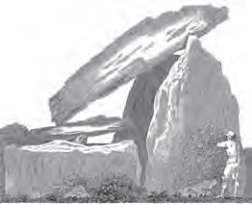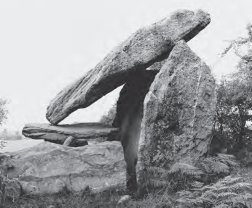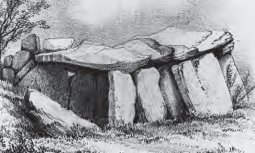


Kilmogue, County Kilkenny
'A proof of the resources, if not the mathematical skill, of our ancestors, for with all the assistance of the improved machinery of the moderns, it is not possible that such ponderous masses could be raised now, and placed in similar positions, with such geometrical accuracy.'The Irish name of this spectacular dolmen is Leac an Scail, sometimes translated as 'the stone of the champion', or alternatively, 'the stone that casts a shadow'. Situated a little over 1/2 mile from Harristown crossroads, 7 miles east-north-east of Carrick-on-Suir, it is partly hidden by rampant hedges in a low-lying corner of a field next to a farmyard. A small stream flows nearby.
Joseph T. Finegan, 1807

Kilmogue dolmen depicted in an engraving of 1809
This is the tallest portal tomb in the country, towering to a height of 15 feet at the front of the steeply angled capstone, whose lower end rests on a horizontal roofstone at the back of the chamber. The majestic portal stones stand 12 feet high and have a tall doorstone between them to close the entrance. Loose material about the base of the tomb shows that it was contained in a cairn of earth and stones, but it is unlikely to have been completely covered over.

A comparable view of the megalith today
Paddock, County Louth
Situated just under 1 mile north-east of the celebrated monastic site of Monasterboice, which is 5 miles north-west of Drogheda, 'Calliagh Birra's House' is a little known and heavily overgrown wedge tomb now incorporated in, and confused by, a field bank. In 1866, when the drawing [featured] was made, the megalith was described as 'in a very good state of preservation'.

Wedge tomb at Paddock, north side of gallery
Standing a little over 4 feet high, the 15-feet long gallery is composed of five stones on each side and roofed with four large flat slabs. The entrance, which unusually for a wedge tomb faces east, is partly destroyed. A curious feature is a series of 'stunted buttresses' set at right angles to the south side of the gallery: they may have linked the customary double-walling found in this class of tomb, but which in this example has been almost completely removed.
Click here to buy the Appletree Press book from Amazon.co.uk. For more information click on: Ireland's Ancient Stones - A Megalithic Heritage by Kenneth McNally, published by Appletree Press.
All Material © 1999-2008 irelandseye.com and contributors Privacy statement
